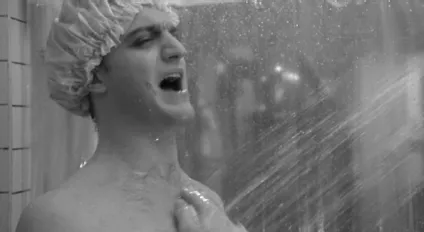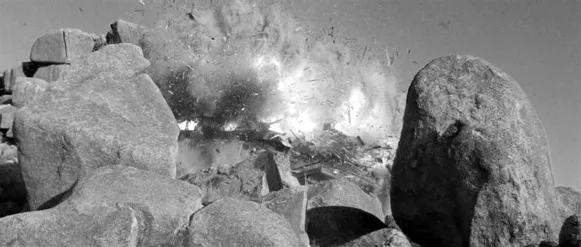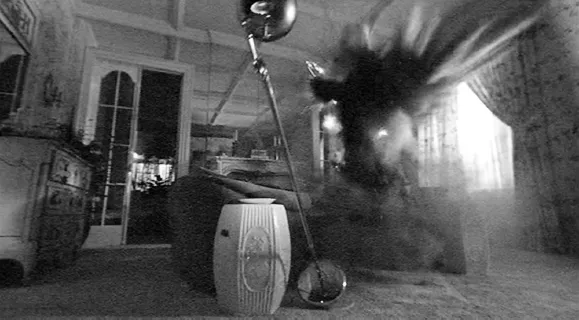![]()
Chapter 1
Shower Scene
I feel about Hitchcock the way I feel about Freud.
– Ann Cvetkovich (1991, 147)
Let us begin with a sequence from Phantom of the Paradise, a film that Pauline Kael (1976, 367) described as “slapstick expressionism.” Talentless rock chanteur Beef is in his dressing room, preparing for his debut on stage at the “ultimate Rock and Roll palace,” the Paradise, a grand Gothic pile owned by the Mabusean rock entrepreneur Swan. The program tonight is a glam-rock musical version of Faust (and – as in The Red Shoes – the performance-text at the center of the film structurally mirrors the movie that contains it). Beef has the opening-night jitters, and he has got them hard – how do we know? Leaving aside the fey, melodramatic tics of Gerrit Graham’s jerky, eye-rolling performance, which are clearly overplayed for a properly Frank Tashlin/Charles Ludlam effect, we might cite the cigarette, pills, and cocaine that Beef ingests all at once, or perhaps the Sirk effect of Beef’s reflection in the dressing-table mirror. We recognize the backstage cliché and think, perhaps, of Judy Garland or any of Jacqueline Susann’s heroines, although at this point (1974? 2012?) there are any number of cinematic quotations that each of us, as viewers, might immediately recognize: so far, barely an hour into the film, there have been explicit references to Rear Window, The Hunchback of Notre Dame, Touch of Evil, The Red Shoes, A Star is Born, The Devil and Daniel Webster (among other permutations of Faust), Citizen Kane, The Cabinet of Dr. Caligari, and (of course) Phantom of the Opera, so from moment to moment, literally anything can happen – anything, that is, that has already happened in another movie.
Case in point: Beef gets up from his dressing table and walks into the bathroom, taking a moment to smile wanly at the surveillance camera that spins to watch him before slamming the door in its eye. Beef drops his bathrobe and enters the shower. He turns on the water and begins singing the opening number from the Faust cantata. As he sings, the camera tracks 180 degrees around Beef, through the cutaway wall of the shower and suddenly into a familiar perspective: a human figure in foreground, facing frame right into the stream of water from the shower head, with a translucent shower curtain behind. In the background left, the door. A “fright chord” has entered on the soundtrack (which is not how Bernard Herrmann did it, but no matter) and the door opens to reveal the Phantom, a figure in a red-and-black cape and exaggerated silver bird mask. The Phantom creeps toward the shower and then, in a brief spasm of montage, cuts open the shower curtain with a knife and – rather than committing the horrifying murder that is supposed to come next – seals Beef’s yelp with a toilet plunger. In his mangled electronic speech, the Phantom warns Beef never to sing his music again – or else. Beef fearfully nods his assent and then, released from the grip of the plunger, he slips downward out of frame, hitting the floor of the shower with a wet thump. Cut.
In one way, this is Brian De Palma’s first “shower scene.” In another way, it is not: structurally speaking, De Palma has already replayed Psycho in its entirety in the form of Sisters, and although in that film the structural gesture we might call The-Unexpected-Murder-of-the-Main-Character-One-Third-of-the-Way-into-the-Film does not take place in a shower, its appearance retains the narrative logic of its progenitor. (There is even a girl-showering-before-being-murdered passage in Murder a la Mod.) In Phantom of the Paradise, however, the scene appears in its “literal” rather than its structural form: shower, person in shower, shower curtain, figure behind curtain, knife, screaming, montage, aggressive musical score for strings (or low-budget electronic approximation thereto). Thus in Sisters and then in Phantom, the “shower scene from Psycho” has been twice instrumentalized: once as an abstractly conceptualized link in a chain of narrative reasoning, and once as a purely literal and visual effect, a series of image-referents that add up to a “quotation.”
After Phantom of the Paradise – which predated The Rocky Horror Picture Show by a year – De Palma would “engage” Hitchcock as a set of useful narrative, structural, and visual strategies in every single one of his movies, at both macro- (Obsession = Vertigo, Dressed To Kill = Psycho) and micro-registers (the “shower scene” in Scarface, the appearance of the massed umbrellas from Foreign Correspondent in The Bonfire of the Vanities, the “romantic” fireworks from To Catch a Thief in Blow Out, the Rififi-via-Marnie theft sequence at CIA headquarters in Mission: Impossible). Sometimes these deployments take the form of a “quotation,” as a signal to a certain kind of viewer that a specific Hitchcock moment is being invoked; sometimes they are used invisibly, as dangerously sophisticated machinery for a specific affective goal, a set of grammatical cues designed to provoke a certain kind of audience response. Dressed to Kill is an ideal example of both types of use occurring at the same time.
Of course Hitchcock is not the only director on De Palma’s mind; one could write a book about the other texts that De Palma “puts to work.” Here one would include (for example) Battleship Potemkin, The Discreet Charm of the Bourgeoisie, Céline et Julie vont en bateau, Last Tango in Paris, The Wild Bunch, Once Upon a Time in America, Model Shop, Zazie dans la Métro, La Nuit Américaine, the Beatles films of Richard Lester, Nick Ray’s Party Girl, the Maysles and Pennebaker ouevres, the films of Sam Fuller, and the work of the Italian modernists, particularly Antonioni – even (and especially) Zabriskie Point, evidently a pivotal film for De Palma. However, it is the relation to Hitchcock that has always occupied the center of most discourse about De Palma, even though few of his mainstream interlocutors have seen fit to think very carefully about the nature of this mobilization.
The point is not that De Palma is so often derided as a “technician” but that this focus on the technical – that is to say, on instrumentalization and directed experimentation – is not recognized as a highly developed strategy. Given that the emphasis in most of the canonical academic treatments of “postmodernism” (Jameson, Harvey, Lyotard) on an element of pastiche or quotation as a presumably new way of creating cultural meaning generally frames this tendency as reactionary or ahistorical, as a necessary structural component in the soul-destroying march toward global ultra-capitalism, it is surely no surprise that De Palma’s engagement with Hitchcock – unlike, as we shall see, his engagement with other coherent directorial sign-systems such as those of Godard or Kubrick (or Peckinpah or Polanski, for that matter) – is the primary mechanism by which De Palma has so often been hoist with his own petard.
Why, exactly, is Hitchcock so “useful”? On the one hand, there is the fact that, more than any other film director living or dead, the movies are Hitchcock, and he they. Like Buñuel, another essential referent for De Palma, Hitchcock stands astride the development of cinema in the twentieth century from the late silent era through the collapse of the Hays code and beyond, and it is hardly controversial to claim that, along with Griffith, Welles, and Busby Berkeley, he provided the visual grammar that defines the mainstream American cinema even today. (“He remains the seminal artist in this form,” De Palma has said of him.) On the other hand, there is the fact that Hitchcock bequeathed a set of concerns – murder, voyeurism, sadism, a certain kind of sexualized power struggle, the technical direction (or manipulation) of the viewer’s affect – that still operate within mainstream cinema not only as dominant narrative tropes but as visual and aural tropes as well. It is important to understand both of these points – the colossal influence that Hitchcock has had over the art form, as well as the specific nature and content of that influence – if we are to understand how the twentieth century might someday be called “the Hitchcock century.” That is to say: it was the century in which the visual and narrative strategies we currently associate with “Hitchcock” came, long before the millenium, to provide the frame within which America, in some way, understood itself.
Zabriskie Point, The Fury.
It is my contention that De Palma, or rather (more accurately) his cinema, “knows” this: movies like Sisters, Blow Out, and even Snake Eyes provide the only sustained investigation (whether “artistic” or “critical-discursive”) of the political and personal implications of living in the “Hitchcock century” – that is to say, of living in a world where everyone, from the cashier at the nearest Arby’s to the chair of Film Studies at your local state university or, for that matter, the chairperson of the Republican National Committee, inevitably imagine themselves to be Hitchcock protagonists. Further, that De Palma’s movies perform, among other important gestures, an investigation of the social and technological conditions of their own possibility – and that they do so through an adaptation of “Hitchcock” as a set of narrative strategies and visual techniques – has to be understood, I think, not only as “the point” of De Palma’s cinema but also as the primary reason why Film Studies, as well as the mainstream film culture in the United States, has at certain junctures been largely content to vilify, if not outright ignore, important works such as Body Double and Raising Cain – and, by extension, to misrecognize, in predictable and yet surprising ways, the logic of De Palma’s system.
I contend that those films of De Palma’s most commonly called “Hitchcockian” constitute a series of logically complete, theoretically rigorous, and politically inflected “interventions” of a comparable (at least!) scale, complexity, and level of accomplishment as anything by William Rothman, Tania Modleski, or Robin Wood. When De Palma (in the Lagier and Voslion documentary Brian De Palma: Les Années 60) says, apropos of Vertigo, that “I’ve been thinking about it for almost forty years,” why shouldn’t we speculate that his thought is theoretically productive? Why can we not understand Body Double as a sort of doctoral thesis about Hitchcock? But in order to answer these questions, others must first appear: what conditions, at what theoretical or social register, allowed “De Palma’s Hitchcock” to be “read” by Hitchcock scholars (and, indeed, by film scholars in general) only through certain prescribed frames? What were those frames, and how did they come to be dominant? What does it mean to watch De Palma (and to watch De Palma’s Hitchcock) through these frames? Asking these questions will mean a lengthy, and narratively unearned, detour away from De Palma into the thickets of film history – a journey, perhaps, toward some kind of disciplinary primal scene.
Hitchcock and the Murder of Marion Crane
[Psycho] – with its seminal shower scene – helped to usher in a cultural paradigm shift from the bland decade of the 1950’s, with its emphasis on togetherness and family values, to the 1960’s, that cataclysmic decade of political assassinations, student protests, free-speech conflicts, race riots, Vietnam protests, and, above all, violence – in our streets, in our political institutions, in our culture, and most vividly in our media, especially in our films, and in our music.
(Skerry 2009, 13)
It is surely the most famous scene in all of film history. At the least, it has generated more discourse – academic discourse, “public discourse,” mainstream, underground, “official,” “fan” – than any other moment in cinema; no other single scene can boast of having so many books devoted exclusively to it. Perhaps inevitably, the “meaning” of the scene changes with each interpretation, at least partially because its literal boundaries (where exactly does the “shower scene” begin, and where does it end?) also change with each interpretation – perhaps metonymically suggesting the idea that the scene, like the movie around it, cannot be contained, that it “seeps out” of its boundaries into the field that is supposedly “merely” its context. There is a sense in all writings about Psycho that the murder of Marion Crane “did” something to America – and something else to the rest of the globe, one presumes, not to mention what it did to “film form” itself. Pauline Kael (1984, 436) references the scene as the most “borderline immoral” moment she had ever experienced in a movie theater, a moment when Hitchcock had taken “the joke” too far; Peter Conrad, in his all-too-revealing The Hitchcock Murders (2000), spends nearly 300 pages dancing around what the scene “did” to him when he saw it as a youth in Australia. (He does not really broach that particular subject in any depth, but he makes two things clear, if only implicitly: first, that Psycho did not turn him into a homosexual, and second, that Psycho did not turn him into a feminist.)
By all accounts, Hitchcock’s “shower scene” constitutes the greatest prank a major director has ever pulled on a film audience. The idea of Psycho as a joke or prank shows up everywhere – from James Naremore in Filmguide to Psycho (1973) to Robert Kolker in Psycho: A Casebook (2004) – but it is always understood as a mark of his genius, whereas De Palma’s jokes are unfunny, sick, and literally harmful to the spectator, as one finds in Thomas Leitch’s “How to Steal from Hitchcock” (2006). Needless to say, there is no way to determine what Psycho “did” to “real people” in “real time” – after all, how would we go about determining the answer? The film’s effects in discourse are easier to identify, although, again, the problem of cause and effect effectively renders this line of inquiry tenuous, if not redundant. One thing is certain: after Alfred Hitchcock murdered Marion Crane, everything changed.
The slippage between author and character is nowhere more symptomatic than this point. Was this indeed, as Pauline Kael hints, the first time that a director had been held personally responsible for the murder of a fictional character? Certainly the idea that Hitchcock had blood on his hands is a sort of meme that has moved through both popular culture and academic discourse for fifty years, with a particularly insistent appearance in feminist writings about film in the twenty years after the 1975 publication of Laura Mulvey’s famous article. But of course Hitchcock can only have blood on his hands if he himself is in the movie wielding the knife, and so there has gradually appeared the notion that Hitchcock inscribes himself in the text in figures such as Norman Bates, or Uncle Charlie in Shadow of a Doubt. The idea of the “director-surrogate character” apparently originated with the Jean Douchet treatment of Rear Window – James Stewart at his window equals Alfred Hitchcock at his camera – but it assumes its most controversial articulation around the character of Norman Bates. William Rothman, for example, is able to read Psycho as a sort of punitive meditation on Hitchcock’s own authorship by performing a rhetorical collapse between Janet Leigh and the figure of the spectator/critic (You, the American male film critic and/or member of the Academy of Motion Picture Arts And Sciences, withhold from me the proper recognition of my artistry? Then I, Alfred Hitchcock, shall break into your bathroom and cut your beautiful naked female body!). It is precisely this logic – albeit in a slightly less metaphoric form – that one sees in letters to Hitchcock from angry parents at the time of the film’s release, complaining about its violence and perversity (see Rebello 1990). Hitchcock murdered that woman, right in front of America’s children, and worse, he did it to her in the naughtiest place in...




